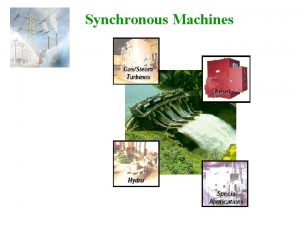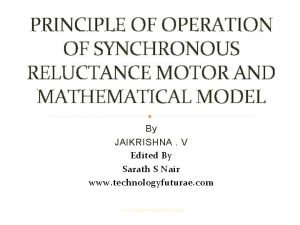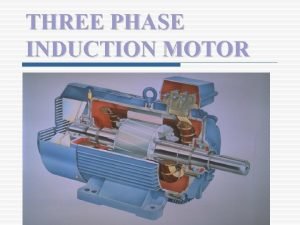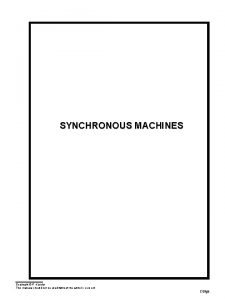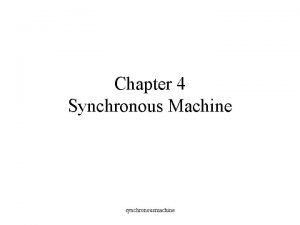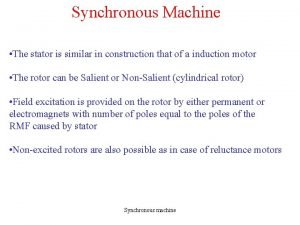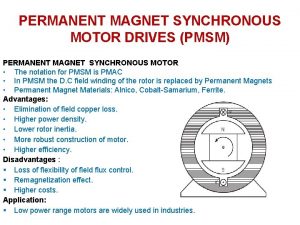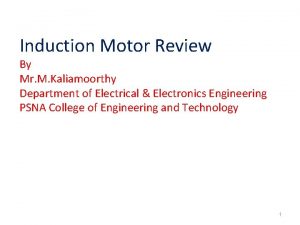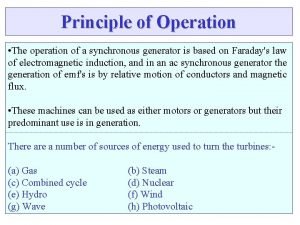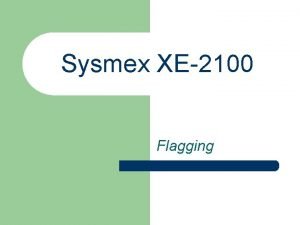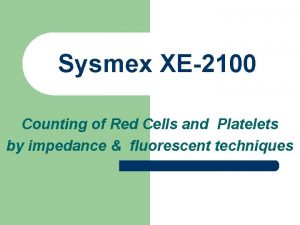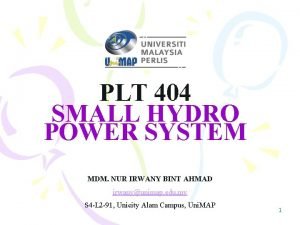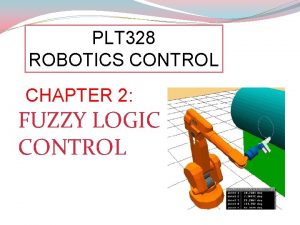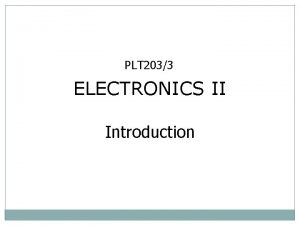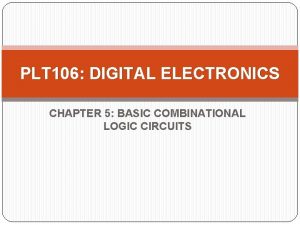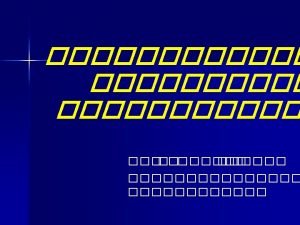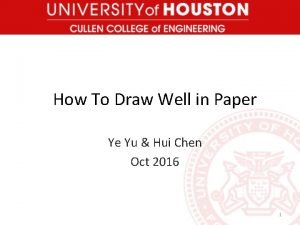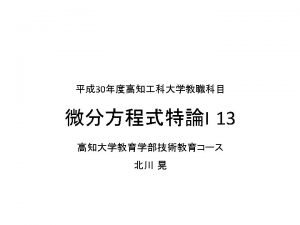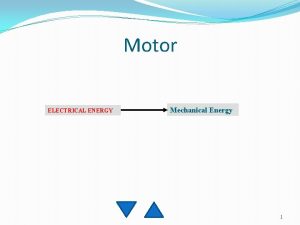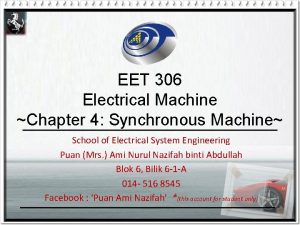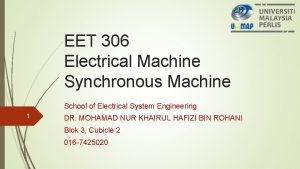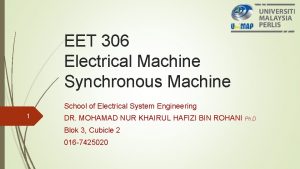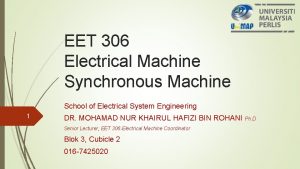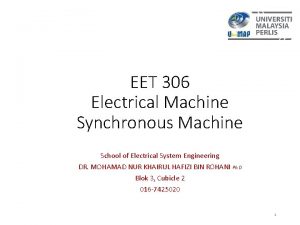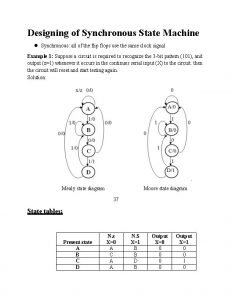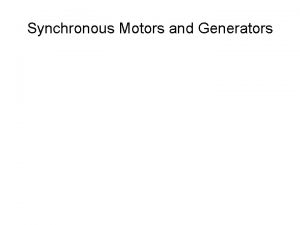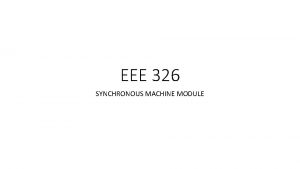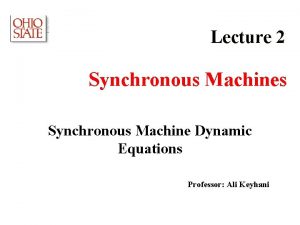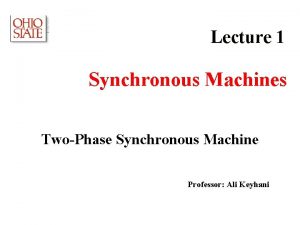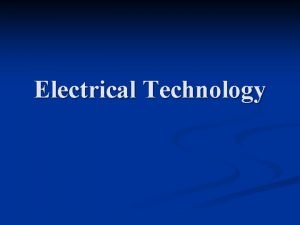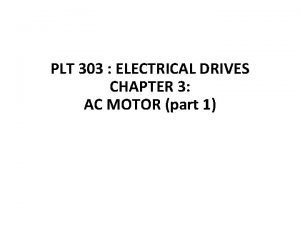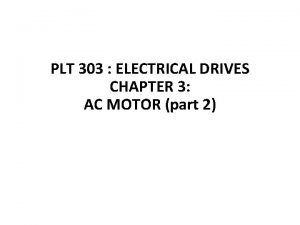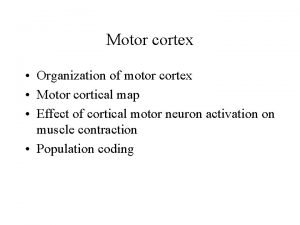PLT 301 Electrical Machine Technology II Synchronous Motor
































- Slides: 32

PLT 301 Electrical Machine Technology II Synchronous Motor Lecturer: Cik Syatirah Binti Mohd Noor Email: syatirah@unimap. edu. my

Synchronous motors The field current IF of the motor produces a steady-state rotor magnetic field BR. A 3 -phase set of voltages applied to the stator produces a 3 -phase current flow in the windings. A 3 -phase set of currents in an armature winding produces a uniform rotating magnetic field Bs. Two magnetic fields are present in the machine, and the rotor field tends to align with the stator magnetic field. Since the stator magnetic field is rotating, the rotor magnetic field will try to catch up pulling the rotor. The larger the angle between two magnetic fields (up to a certain maximum), the greater the torque on the rotor of the machine.

Synchronous motor equivalent circuit A synchronous motor has the same equivalent circuit as synchronous generator, except that the direction of power flow (and the direction of IA) is reversed. Per-phase circuit is shown: A change in direction of IA changes the Kirchhoff’s voltage law equation: (7. 69. 1) Therefore, the internal generated voltage is (7. 69. 2) We observe that this is exactly the same equation as the equation for the generator, except that the sign on the current terms is reversed.

Synchronous motor vs. synchronous generator Let us suppose that a phasor diagram of synchronous generator is shown. BR produces EA, Bnet produces V , and BS produces Estat = -j. XSIA. The rotation on both diagrams is counterclockwise and the induced torque is (7. 70. 1) clockwise, opposing the direction of rotation. In other words, the induced torque in generators is a counter-torque that opposes the rotation caused by external torque. If the prime mover loses power, the rotor will slow down and the rotor field BR will fall behind the magnetic field in the machine Bnet. Therefore, the operation of the machine changes…

Synchronous motor vs. synchronous generator The induced torque becomes counter-clockwise, being now in the direction of rotation. The machine starts acting as a motor. The increasing torque angle results in an increasing torque in the direction of rotation until it equals to the load torque. At this point, the machine operates at steady state and synchronous speed but as a motor. Notice that, since the direction of IA is changed between the generator and motor actions, the polarity of stator voltage (-j. XSIA) also changes. In a summary: in a generator, EA lies ahead of V , while in a motor, EA lies behind V.

Steady-state operation of motor: Torque-speed curve Usually, synchronous motors are connected to large power systems (infinite bus); therefore, their terminal voltage and system frequency are constant regardless the motor load. Since the motor speed is locked to the electrical frequency, the speed should be constant regardless the load. The steady-state speed of the motor is constant from no-load to the maximum torque that motor can supply (pullout torque). Therefore, the speed regulation of synchronous motor is 0%. The induced torque is (7. 72. 1) or (7. 72. 2)

Steady-state operation of motor: Torque-speed curve The maximum pullout torque occurs when = 900: (7. 73. 1) Normal full-load torques are much less than that (usually, about 3 times smaller). When the torque on the shaft of a synchronous motor exceeds the pullout torque, the rotor can no longer remain locked to the stator and net magnetic fields. It starts to slip behind them. As the motor slows down, the stator magnetic field “laps” it repeatedly, and the direction of the induced torque in the rotor reverses with each pass. As a result, huge torque surges of alternating direction cause the motor vibrate severely. The loss of synchronization after the pullout torque is exceeded is known as slipping poles.

Steady-state operation of motor: Effect of torque changes Assuming that a synchronous motor operates initially with a leading PF. If the load on the motor increases, the rotor initially slows down increasing the torque angle . As a result, the induced torque increases speeding up the rotor up to the synchronous speed with a larger torque angle . Since the terminal voltage and frequency supplied to the motor are constant, the magnitude of internal generated voltage must be constant at the load changes (EA = K and field current is constant).

Steady-state operation of motor: Effect of torque changes Assuming that the armature resistance is negligible, the power converted from electrical to mechanical form in the motor will be the same as its input power: (7. 73. 1) Since the phase voltage is constant, the quantities IAcos and EAsin are directly proportional to the power supplied by (and to) the motor. When the power supplied by the motor increases, the distance proportional to power increases. Since the internal generated voltage is constant, its phasor “swings down” as load increases. The quantity j. XSIA has to increase; therefore, the armature current IA increases too. Also, the PF angle changes too moving from leading to lagging.

Steady-state operation of motor: Effect of field current changes Assuming that a synchronous motor operates initially with a lagging PF. If, for the constant load, the field current on the motor increases, the magnitude of the internal generated voltage EA increases. Since changes in IA do not affect the shaft speed and the motor load is constant, the real power supplied by the motor is unchanged. Therefore, the distances proportional to power on the phasor diagram (EAsin and IAcos ) must be constant. Notice that as EA increases, the magnitude of the armature current IA first decreases and then increases again. At low EA, the armature current is lagging and the motor is an inductive load that consumes reactive power Q. As the field current increases , IA eventually lines up with V , and the motor is purely resistive. As the field current further increases, IA becomes leading and the motor is a capacitive load that supplies reactive power Q to the system (consumes –Q).

Steady-state operation of motor: Effect of field current changes A plot of armature current vs. field current is called a synchronous motor V curves for different levels of real power have their minimum at unity PF, when only real power is supplied to the motor. For field currents less than the one giving the minimum IA, the armature current is lagging and the motor consumes reactive power. For field currents greater than the one giving the minimum IA, the armature current is leading and the motor supplies reactive power to the system. Therefore, by controlling the field current of a synchronous motor, the reactive power consumed or supplied to the power system can be controlled.

Steady-state operation of motor: Effect of field current changes When the projection of the phasor EA onto V (EAcos ) is shorter than V , a synchronous motor has a lagging current and consumes Q. Since the field current is small in this situation, the motor is sais to be under-excited. When the projection of the phasor EA onto V (EAcos ) is longer than V , a synchronous motor has a leading current and supplies Q to the system. Since the field current is large in this situation, the motor is sais to be overexcited.

Steady-state operation of motor: power factor correction Assuming that a load contains a synchronous motor (whose PF can be adjusted) in addition to motors of other types. What does the ability to set the PF of one of the loads do for the power system? Let us consider a large power system operating at 480 V. Load 1 is an induction motor consuming 100 k. W at 0. 78 PF lagging, and load 2 is an induction motor consuming 200 k. W at 0. 8 PF lagging. Load 3 is a synchronous motor whose real power consumption is 150 k. W. a. If the synchronous motor is adjusted to 0. 85 PF lagging, what is the line current? b. If the synchronous motor is adjusted to 0. 85 PF leading, what is the line current? c. Assuming that the line losses are PLL = 3 IL 2 RL, how du these losses compare in the two cases?

Steady-state operation of motor: power factor correction a. The real power of load 1 is 100 k. W, and the reactive power of load 1 is The real power of load 2 is 200 k. W, and the reactive power of load 2 is The real power of load 3 is 150 k. W, and the reactive power of load 3 is The total real load is The total reactive load is The equivalent system PF is The line current is

Steady-state operation of motor: power factor correction b. The real and reactive powers of loads 1 and 2 are the same. The reactive power of load 3 is The total real load is The total reactive load is The equivalent system PF is The line current is

Steady-state operation of motor: power factor correction c. The transmission line losses in the first case are The transmission line losses in the second case are We notice that the transmission power losses are 28% less in the second case, while the real power supplied to the loads is the same.

Steady-state operation of motor: power factor correction The ability to adjust the power factor of one or more loads in a power system can significantly affect the efficiency of the power system: the lower the PF, the greater the losses in the power lines. Since most loads in a typical power system are induction motors, having one or more over-excided synchronous motors (leading loads) in the system is useful for the following reasons: 1. A leading load supplies some reactive power to lagging loads in the system. Since this reactive power does not travel along the transmission line, transmission line current is reduced reducing power losses. 2. Since the transmission line carries less current, the line can be smaller for a given power flow reducing system cost. 3. The over-excited mode of synchronous motor increases the motor’s maximum torque. Usage of synchronous motors or other equipment increasing the overall system’s PF is called power-factor correction. Since a synchronous motor can provide PF correction, many loads that can accept constant speed are driven by over-excited synchronous motors.

Starting synchronous motors Consider a 60 Hz synchronous motor. When the power is applied to the stator windings, the rotor (and, therefore its magnetic field BR) is stationary. The stator magnetic field BS starts sweeping around the motor at synchronous speed. Note that the induced torque on the shaft (7. 84. 1) is zero at t = 0 since both magnetic fields are aligned. At t = 1/240 s the rotor has barely moved but the stator magnetic field BS has rotated by 900. Therefore, the torque on the shaft is non-zero and counter-clockwise.

Starting synchronous motors At t = 1/120 s the rotor and stator magnetic fields point in opposite directions, and the induced torque on the shaft is zero again. At t = 3/240 s the stator magnetic fields point to the right, and the induced torque on the shaft is nonzero but clockwise. Finally, at t = 1/60 s the rotor and stator magnetic fields are aligned again, and the induced torque on the shaft is zero. During one electrical cycle, the torque was counter-clockwise and then clockwise, and the average torque is zero. The motor will vibrate heavily and finally overheats!

Starting synchronous motors Three basic approaches can be used to safely start a synchronous motor: 1. Reduce the speed of the stator magnetic field to a low enough value that the rotor can accelerate and two magnetic fields lock in during one half-cycle of field rotation. This can be achieved by reducing the frequency of the applied electric power (which used to be difficult but can be done now). 2. Use an external prime mover to accelerate the synchronous motor up to synchronous speed, go through the paralleling procedure, and bring the machine on the line as a generator. Next, turning off the prime mover will make the synchronous machine a motor. 3. Use damper windings or amortisseur windings – the most popular.

Motor starting by amortisseur or damper windings Amortisseur (damper) windings are special bars laid into notches carved in the rotor face and then shorted out on each end by a large shorting ring.

Motor starting by amortisseur or damper windings A diagram of a salient 2 -pole rotor with an amortisseur winding, with the shorting bars on the ends of the two rotor pole faces connected by wires (not quite the design of actual machines). We assume initially that the rotor windings are disconnected and only a 3 phase set of voltages are applied to the stator. At t = 0, assume that BS (stator field) is vertical. As BS sweeps along in s counter-clockwise direction, it induces a voltage in bars of the amortisseur winding: (7. 88. 1)

Motor starting by amortisseur or damper windings Here v – the velocity of the bar relative to the magnetic field; B – magnetic flux density vector; l – length of conductor in the magnetic field. The bars at the top of the rotor are moving to the right relative to the magnetic field: a voltage, with direction out of page, will be induced. Similarly, the induced voltage is into the page in the bottom bars. These voltages produce a current flow out of the top bars and into the bottom bars generating a winding magnetic field Bw to the right. Two magnetic fields will create a torque (7. 89. 1) The resulting induced torque will be counter-clockwise.

Motor starting by amortisseur or damper windings At t = 1/240 s, BS has rotated 900 while the rotor has barely moved. Since v is parallel to BS, the voltage induced in the amortisseur windings is zero, therefore, no current in wires create a zero-torque. At t = 1/120 s, BS has rotated another 900 and the rotor is still. The voltages induced in the bars create a current inducing a magnetic field pointing to the left. The torque is counter-clockwise. Finally, at t = 3/240 s, no voltage is induced in the amortisseur windings and, therefore, the torque will be zero.

Motor starting by amortisseur or damper windings We observe that the torque is either counter-clockwise or zero, but it is always unidirectional. Since the net torque is nonzero, the motor will speed up. However, the rotor will never reach the synchronous speed! If a rotor was running at the synchronous speed, the speed of stator magnetic field BS would be the same as the speed of the rotor and, therefore, no relative motion between the rotor and the stator magnetic field. If there is no relative motion, no voltage is induced and, therefore, the torque will be zero. Instead, when the rotor’s speed is close to synchronous, the regular field current can be turned on and the motor will operate normally. In real machines, field circuit are shorted during starting. Therefore, if a machine has damper winding: 1. Disconnect the field windings from their DC power source and short them out; 2. Apply a 3 -phase voltage to the stator and let the rotor to accelerate up to nearsynchronous speed. The motor should have no load on its shaft to enable motor speed to approach the synchronous speed as closely as possible; 3. Connect the DC field circuit to its power source: the motor will lock at synchronous speed and loads may be added to the shaft.

Relationship between synchronous generators and motors Synchronous generator and synchronous motor are physically the same machines! A synchronous machine can supply real power to (generator) or consume real power (motor) from a power system. It can also either consume or supply reactive power to the system. 1. The distinguishing characteristic of a synchronous generator (supplying P) is that EA lies ahead of V while for a motor EA lies behind V. 2. The distinguishing characteristic of a machine supplying reactive power Q is that Eacos > V (regardless whether it is a motor or generator). The machine consuming reactive power Q has Eacos < V .

Synchronous machine ratings The speed and power that can be obtained from a synchronous motor or generator are limited. These limited values are called ratings of the machine. The purpose of ratings is to protect the machine from damage. Typical ratings of synchronous machines are voltage, speed, apparent power (k. VA), power factor, field current and service factor. 1. Voltage, Speed, and Frequency The rated frequency of a synchronous machine depends on the power system to which it is connected. The commonly used frequencies are 50 Hz (Europe, Asia), 60 Hz (Americas), and 400 Hz (special applications: aircraft, spacecraft, etc. ). Once the operation frequency is determined, only one rotational speed in possible for the given number of poles: (7. 93. 1)

Synchronous machine ratings A generator’s voltage depends on the flux, the rotational speed, and the mechanical construction of the machine. For a given design and speed, the higher the desired voltage, the higher the flux should be. However, the flux is limited by the field current. The rated voltage is also limited by the windings insulation breakdown limit, which should not be approached closely. Is it possible to operate a synchronous machine at a frequency other than the machine is rated for? For instance, can a 60 Hz generator operate at 50 Hz? The change in frequency would change the speed. Since EA = K , the maximum allowed armature voltage changes when frequency changes. Specifically, if a 60 Hz generator will be operating at 50 Hz, its operating voltage must be derated to 50/60 or 83. 3 %.

Synchronous machine ratings 2. Apparent power and Power factor Two factors limiting the power of electric machines are 1) Mechanical torque on its shaft (usually, shaft can handle much more torque) 2) Heating of the machine’s winding The practical steady-state limits are set by heating in the windings. The maximum acceptable armature current sets the apparent power rating for a generator: (7. 95. 1) If the rated voltage is known, the maximum accepted armature current determines the apparent power rating of the generator: (7. 95. 2) The power factor of the armature current is irrelevant for heating the armature windings.

Synchronous machine ratings The stator cupper losses also do not depend on the current angle: (7. 96. 1) Since the current angle is irrelevant to the armature heating, synchronous generators are rated in k. VA rather than in KW. The rotor (field winding) cupper losses are: (7. 96. 2) Allowable heating sets the maximum field current, which determines the maximum acceptable armature voltage EA. These translate to restrictions on the lowest acceptable power factor: The current IA can have different angles (that depends on PF). EA is a sum of V and j. XSIA. We see that, (for a constant V ) for some angles the required EA exceeds its maximum value.

Synchronous machine ratings If the armature voltage exceeds its maximum allowed value, the windings could be damaged. The angle of IA that requires maximum possible EA specifies the rated power factor of the generator. It is possible to operate the generator at a lower (more lagging) PF than the rated value, but only by decreasing the apparent power supplied by the generator. Synchronous motors are usually rated in terms of real output power and the lowest PF at full-load conditions. 3. Short-time operation and service factor A typical synchronous machine is often able to supply up to 300% of its rated power for a while (until its windings burn up). This ability to supply power above the rated values is used to supply momentary power surges during motor starts. It is also possible to use synchronous machine at powers exceeding the rated values for longer periods of time, as long as windings do not have time to hit up too much before the excess load is removed. For instance, a generator that could supply 1 MW indefinitely, would be able to supply 1. 5 MW for 1 minute without serious harm and for longer periods at lower power levels.

Synchronous machine ratings The maximum temperature rise that a machine can stand depends on the insulation class of its windings. The four standard insulation classes with they temperature ratings are: A – 600 C above the ambient temperature B – 800 C above the ambient temperature F – 1050 C above the ambient temperature H – 1250 C above the ambient temperature The higher the insulation class of a given machine, the greater the power that can be drawn out of it without overheating its windings. The overheating is a serious problem and synchronous machines should not be overheated unless absolutely necessary. However, power requirements of the machine not always known exactly prior its installation. Because of this, generalpurpose machines usually have their service factor defined as the ratio of the actual maximum power of the machine to the rating on its plate. For instance, a machine with a service factor of 1. 15 can actually be operated at 115% of the rated load indefinitely without harm.
 Pony motor starting method diagram
Pony motor starting method diagram Synchronous motor hunting
Synchronous motor hunting Pony motor starting synchronous motor
Pony motor starting synchronous motor Synchronous motor and generator
Synchronous motor and generator Relucatnce
Relucatnce Parts of 3 phase induction motor
Parts of 3 phase induction motor Synchronous motor equations
Synchronous motor equations Synchronous motor phasor diagram
Synchronous motor phasor diagram Direct axis and quadrature axis
Direct axis and quadrature axis Permanent magnet synchronous motor types
Permanent magnet synchronous motor types Induction motor power equation
Induction motor power equation What is load angle
What is load angle Wbc abn scattergram meaning
Wbc abn scattergram meaning Plt histogram abn
Plt histogram abn Micro hydro power
Micro hydro power Distribuzione volumetrica plt
Distribuzione volumetrica plt Plt scheme
Plt scheme Plt fuzzy set
Plt fuzzy set Plt electronics
Plt electronics Plt 106
Plt 106 Plt 403
Plt 403 Fcps my plt
Fcps my plt Plt cbc
Plt cbc Uts plt
Uts plt Plt morphology
Plt morphology Plt morphology
Plt morphology Import numpy as np import matplotlib.pyplot as plt
Import numpy as np import matplotlib.pyplot as plt Anu law electives
Anu law electives Al culture
Al culture Plt.triplot
Plt.triplot Billy b and plt
Billy b and plt Plt skills
Plt skills Plt skills
Plt skills



